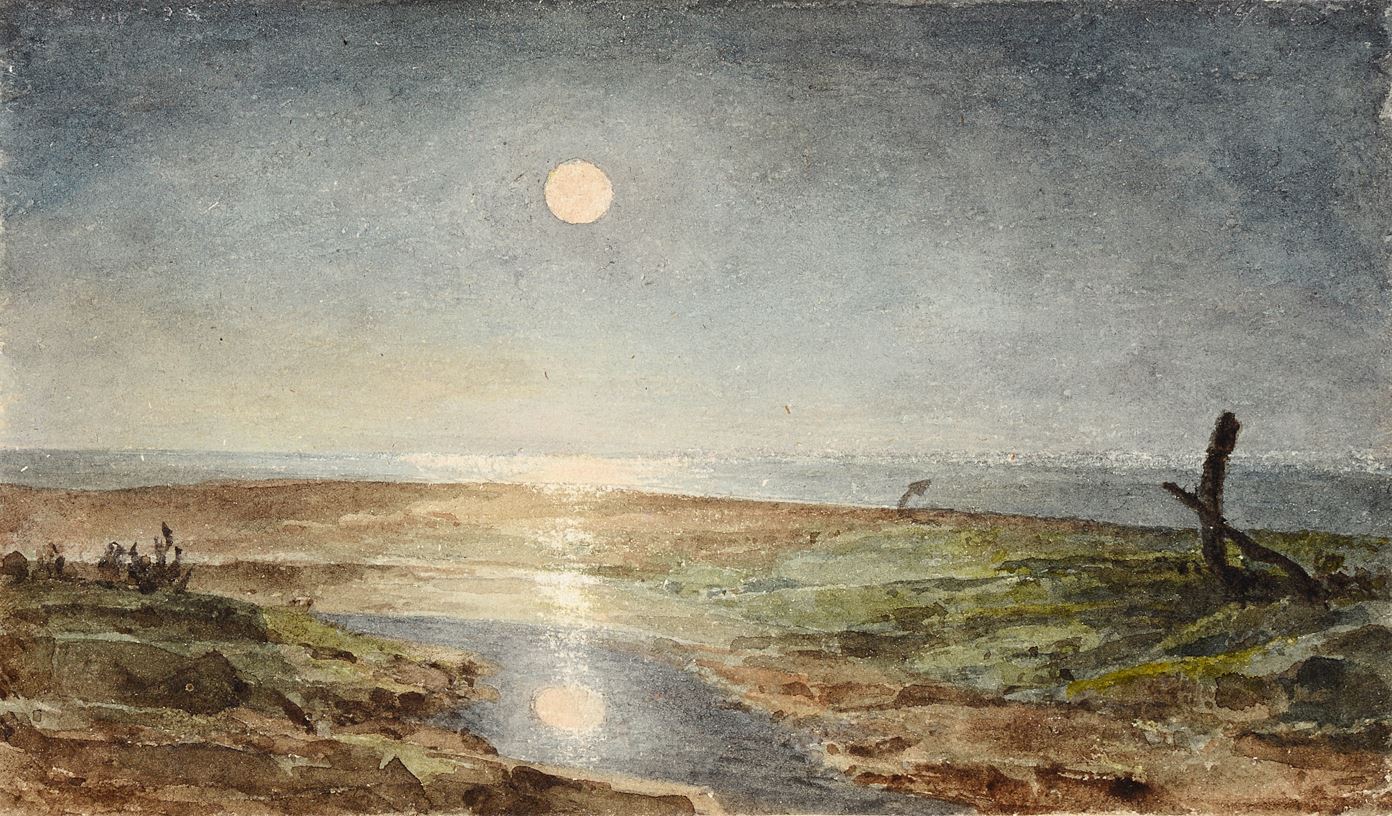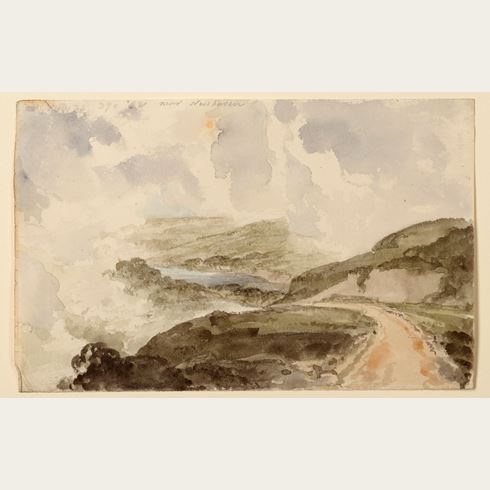Joseph Michael GANDY
(London 1771 - Plympton 1843)
Near Southwick, Shoreham, West Sussex
Sold
Watercolour, with scratching out, over an underdrawing in pencil.
Colour beginnings in watercolour and a compass in grey ink on the verso.
Inscribed 31 Aug 22 at the upper left and 8 o/c / S at the upper right.
Further inscribed near Southwick / Shoreham / 31 Aug 22 8 o/c SE on the verso.
109 x 184 mm. (4 1/4 x 7 1/4 in.)
Colour beginnings in watercolour and a compass in grey ink on the verso.
Inscribed 31 Aug 22 at the upper left and 8 o/c / S at the upper right.
Further inscribed near Southwick / Shoreham / 31 Aug 22 8 o/c SE on the verso.
109 x 184 mm. (4 1/4 x 7 1/4 in.)
Many of Joseph Gandy’s topographical drawings and watercolours serve as a form of diary and travelogue, a practice he had begun during his period of study in Italy between 1794 and 1797, when he went on sketching expeditions in the Campagna. According to the artist’s annotations on the sheet, this watercolour was drawn at 8 o’clock on the 31st of August, 1822, on the beach at Shoreham in West Sussex, on the south coast of England.
The present sheet was one of several landscape sketches by Gandy from the 1820’s which were acquired from him by his friend, the Neoclassical sculptor Sir Richard Westmacott (1775-1856). Westmacott had studied in Rome with Gandy, and sometimes purchased works from his often impecunious friend. He later assembled these watercolours into two albums which he gave to his daughter Maria Poole. One of these albums is today in the Sir John Soane Museum in London, while the other album was eventually broken up and the drawings dispersed in 2004. The present sheet was part of this second album, which was titled GANDY / VOL II / LANDSCAPE on the spine, and inscribed, by Richard Westmacott, Gandy’s sketches / I give / Maria on the inside cover. The album contained 97 watercolours of landscapes and studies from nature, variously inscribed and dated between the 15th of July 1820 and the 5th of July 1826. The album contained watercolour landscapes drawn in London and its outskirts, as well as various views in Surrey, East and West Sussex, and Kent on the southeast coast of England, as well as a number of studies of skies, clouds, sunsets, storms and nocturnal views. Many of the watercolours – which appear to have come from one or more sketchbooks used by the artist - were inscribed by Gandy with the location, date and time that the views were made, as well as the compass direction of the view chosen.
Another watercolour by Gandy from the same Westmacott album – a view of Shoreham, dated 31 August 1822 and drawn only an hour earlier than the present sheet - is today in the Hilliard collection in Chicago.
The present sheet was one of several landscape sketches by Gandy from the 1820’s which were acquired from him by his friend, the Neoclassical sculptor Sir Richard Westmacott (1775-1856). Westmacott had studied in Rome with Gandy, and sometimes purchased works from his often impecunious friend. He later assembled these watercolours into two albums which he gave to his daughter Maria Poole. One of these albums is today in the Sir John Soane Museum in London, while the other album was eventually broken up and the drawings dispersed in 2004. The present sheet was part of this second album, which was titled GANDY / VOL II / LANDSCAPE on the spine, and inscribed, by Richard Westmacott, Gandy’s sketches / I give / Maria on the inside cover. The album contained 97 watercolours of landscapes and studies from nature, variously inscribed and dated between the 15th of July 1820 and the 5th of July 1826. The album contained watercolour landscapes drawn in London and its outskirts, as well as various views in Surrey, East and West Sussex, and Kent on the southeast coast of England, as well as a number of studies of skies, clouds, sunsets, storms and nocturnal views. Many of the watercolours – which appear to have come from one or more sketchbooks used by the artist - were inscribed by Gandy with the location, date and time that the views were made, as well as the compass direction of the view chosen.
Another watercolour by Gandy from the same Westmacott album – a view of Shoreham, dated 31 August 1822 and drawn only an hour earlier than the present sheet - is today in the Hilliard collection in Chicago.
An architect by profession, Joseph Gandy was trained in the office of James Wyatt from 1786 onwards, before enrolling in the Royal Academy Schools in 1789. Following a period of three years spent in Rome, he returned to London where he was employed as a draughtsman by the architect Sir John Soane, for whom he began working in 1798. Although long regarded by scholars as merely an employee of Soane, translating the latter’s architectural designs into full-scale watercolours, it is now known that Gandy often produced drawings after his own inventions. (That he was certainly held in high regard by Soane is shown in the comments made by the architect in a lecture presented at the Royal Academy in 1813: ‘A superior manner of Drawing is absolutely necessary, indeed it is impossible not to admire the beauties and almost magical effects in the architectural drawings of a Clérisseau, a Gandy, or a Turner.’) Gandy maintained a modest architectural practice of his own, and regularly exhibited a remarkable series of large-scale architectural history watercolours and capriccios - grandiose subjects inspired by Ancient Greece and Rome – in the architecture section at the Royal Academy between 1789 and 1833. (He also showed fourteen works at the British Institution in 1820 and 1821). In 1803, Gandy was admitted as an Associate of the Royal Academy, largely on the strengths of his undoubted skills as an architectural draughtsman, and despite the fact at that time he had not received any commissions as a practicing architect. (Indeed, he achieved no further promotion within the Academy, and was never elected an Academician.) Gandy also produced a number of designs for stage sets, and contributed drawings to the antiquarian topographer John Britton’s The Architectural Antiquities of Great Britain, published between 1807 and 1826, and The Cathedral Antiquities of England, which appeared between 1814 and 1835.
Provenance
Acquired from the artist by Richard Westmacott and placed into an album
The album given to his daughter, Maria Poole, née Westmacott
Thence by descent until sold, London, Christie’s, 20 November 2003, lot 7
Richard L. Feigen & Co., New York
Jan Krugier and Marie-Anne Poniatowski, Geneva.
The album given to his daughter, Maria Poole, née Westmacott
Thence by descent until sold, London, Christie’s, 20 November 2003, lot 7
Richard L. Feigen & Co., New York
Jan Krugier and Marie-Anne Poniatowski, Geneva.
Literature
Suzanne Folds McCullagh, ed., Dreams & Echoes: Drawings and Sculpture in the David and Celia Hilliard Collection, exhibition catalogue, Chicago, 2013-2014, p.79, under no.28 (entry by Brian Lukacher).
Exhibition
New York, Richard L. Feigen & Co., Joseph Gandy: Visionary Views of England, 2004, no.37.







